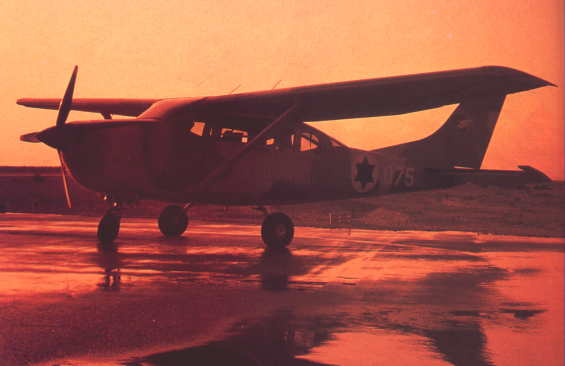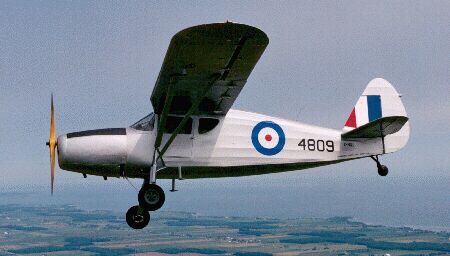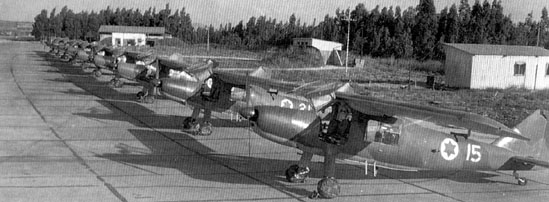
Produced during the late 1930s, the Taylorcraft BL was a light trainer with two side-by-side seats. It one of a family of such aircraft, over 2,400 of which were built.
In its bid to expel the British from Palestine, the underground Irgun Tzvai Leumi (a.k.a the Irgun or the Eztel, its hebrew acronym) had initiated the establishment of its own armed forces and its own air force.
In 1937 Haim Moshe Katz, an American entrepeneur, formed the "Palestine Flying Service" to train pilots using his single de-Havilland Gipsy Moth. The service was grounded however, when its sole aircraft was damaged in June 1938. When the Irgun learned of Katz's activities, it enlisted him to form the
organization's flight school, and in December 1938 even provided the service with another aircraft and
instructor. Edwin Laibowitz, an American veteran of the Spanish Civil War arrived in Palestine with his private Taylorcraft A, and the Irgun arranged his employment with Katz. The service was shortly later reinforced with two more aircraft when two Taylorcraft BLs arrived from the U.S. by boat. The BLs wore a
bright red livery and were operated out of Lod airport, along with the service's Taylorcraft A. Two Irgun pilot classes had been completed before the flight school was forced to close down. The outbreak of World War II brought about economic difficulties, and after the RAF took over Lod airport Katz was forced to cease
his operations and sell his aircraft to "Aviron", one of the first airlines in Palestine.
By the end of the war another underground Jewish organization had begun training its own pilots. The close ties between "Aviron" and the "Haganah" movement, allowed the establishment of a "Palmach" (the "Haganah"'s elite conscripted force) flight school within "Aviron"'s school at Ramla and the use of "Aviron" aircraft
for various other activities. The high wing configuration of the Taylorcraft made it a highly suitable platform for aerial intelligence gathering and the "Palmach" employed the aircraft for photo reconainssance.
On October 29th 1947 the United Nations voted to partition Palestine into two separate Arab and Jewish states and the Israeli War of Independence broke out. Following the establishment of the "Shirut Avir" (air service) on November 2nd 1947, "Aviron" transferred its two Taylorcraft BLs to the newly formed service.
On December 13th 1947 the three Taylorcraft, the two "Shirut Avir" BLs and "Aviron"'s remaining Taylorcraft A were smuggled from Lod Airport ("Aviron" had left Ramla for Lod about a month before) to Tel-Aviv's Sde-Dov following attacks by local Arabs against Jewish employees. Sde-Dov was not yet a fully operational
airport and had no permanent fuel facilities. For a number of weeks, until such facilities were built, "Aviron"'s Taylorcraft A was routinely flown between Sde-Dov and Lod to deliver fuel for the service's small collection of light aircraft. In February 1948 one of the Taylorcraft BLs hit a shack upon landing at Sde-Dov but was quickly returned to service. The aircrafts' engines were also used for technical training of ground crews.
In April 1948 the "Shirut Avir" was reorganized and its aircraft reallocated between the various squadrons.
One Taylorcraft BL went to the 3rd "Lavi" (young lion) squadron based in Yavniel in northern Israel while another went to the 2ng "Gamal" (camel) squadron at Nir-Am in southern Israel. Although the aircraft were primarily employed in transport and liaison roles, they also saw some combat. One such occasion took place on May 12th when one Taylorcraft bombed a Palestinian army camp near Gaza, although the limited payload allowed for a very small bombload.
The aircraft were in service until the end of the War of Independence in early 1949, when they were retired.
Specification: Taylorcraft BL
Type: light training and utility aircraft.
Powerplant: one Lycoming A2-0-145.
Performance: max speed - 163km/h, max range - 440km.
Weights: empty - 325kg, max takeoff - 545kg.
Dimensions: span - 10.97m, length - 6.71m, height - 2.03m.
Armament: none.

The Fairchild model F-24, first flown in 1936, was designed and built for civil use but saw extensive military service during World War II. Known as the UC-61 Forwarder in the U.S. Army Air Force, the name Argus was given to it by the RAF which used it in the U.K., the Middle East and the Far East.
Four Fairchild Arguses served with the "Shirut Avir" (air service) and its successor, the IAF, during the War of Independence. In early 1948, Boris Senior, a South African pilot enlisted by the "Haganah", managed to purchase 3 Arguses in South Africa, aided by funding from the supportive local Jewish population. Before
these aircraft had arrived in Palestine however, the "Shirut Avir" managed to lay its hands on another Argus, captured by the "Negev" brigade from an Egyptian drugs smuggler on April 16th. The pilot had landed near Tze'elim, a Jewish settlement in the Negev, damaging the landing gear in the process. A Jewish force
which had arrived at the scene arrested the pilot and fixed the damage inflicted to the aircraft, while
pilots from the "Shirut Avir" arrived the following day and flew the aircraft to Sde-Dov. After the Egyptian markings were removed from the Argus, it was flown to Yavniel in northern Israel, where it became part of
the "Shirut Avir"'s northern "Galil" squadron. Fearing a confiscation of the plane by the British, the "Galil" squadron was prohibited from operating the plane and it was hidden in a nearby wood. On April 28th however, the "Haganah" launched operation "Yiftah" to liberate the Galilee, and the "Galil" squadron (which
in the service's reorganization eight days before had become the "Lavi", lion cub, squadron) nonetheless pressed the Argus into service, disobeying the "Shirut Avir"'s directive. While most missions were simple supply and evacuation missions, the Argus became the squadron's "heavy bomber", and carried out bombing and
straffing missions as well. It was damaged and grounded some time before May 12th but was shortly later fixed and returned to service.
On May 15th 1948 two of the three South African Arguses finally arrived at Sde-Dov. The three aircraft had already left South Africa in early April, but obstacles encountered on their way delayed their arrival. On May 7th, after a week's rest at Cairo, the pilots had hoped to fool Egyptian authorities by taking off westwards and then turning back east towards Palestine, but were prevented from doing this by a flight of Egyptian Spitfires. Forced to make a detour, the planes journeyed throught North Africa, Sardinia, Italy and Greece to Cyprus, their final stop before arriving at Sde-Dov. Delayed at Athens, the third aircraft landed at Haifa on the following day, May 16th. The three aircraft were quickly pressed into service with the "Shirut Avir", mainly in the transport and liaison roles but as attack aircraft as well. One such occasion took place on June 1st 1948 when one of the Fairchilds participated a bombing of the Jordanian capital Amman, in anticipation of an Arab League summit about to take place.
Only one IAF Fairchild managed to make it through the War of Independence, the rest having been destroyed by its end. The captured Egyptian Argus was lost on June 4th 1948, attacking an Egyptian flotilla bombarding Tel-Aviv. Attempting to attack the frigates with hand thrown bombs but with no sights, the plane was caught in the ships' anti aircraft fire and crashed into the sea, killing both pilots. Another Argus was lost taking off from Yavniel. The remaining Fairchild was sold off to a private operator after the end of the war.
Specification: Fairchild F-24R Argus
Type: light utility & liaison aircraft.
Powerplant: one Ranger B1-6-410.
Performance: max speed - 109 knots, cruising speed - 97 knots, ceiling - 13,500ft, range - 885km, rate of climb - 550 ft/min.
Weights: empty - 692kg, max takeoff - 1,157kg.
Dimensions: span - 11.07m, length - 7.28m, height - 2.3m.
Armament: none.

The Do-27 was the first aircraft to enter production in Germany after World War II. The prototype of the Do-27 was first flown on April
8th 1955 and the first production aircraft in October 1956. By the time production ended in 1965, over 600 examples had been built. The
type's largest operator was West Germany but the type as also served with the Belgian and Swiss air forces.
The IAF begun operating the Do-27 in October 1964 when the first 10 examples entered service with the 100th "Flying Camel" Squadron at Sde-Dov.
With more aircraft arriving after the 1967 Six Days War, the Do-27 fleet would eventually consist of 35 examples.
Nicknamed "Dror" (sparrow), the Do-27 could carry between 4 and 6 passengers. The type's excellent STOL capabilities allowed the type to play a
large number of roles, among them liason, light observation, artillery spotting and maritime patrol. The aircraft were routinely used in operations against
Palestinians infiltrating into Israeli territory from Jordan in the late 1960s, spotting and tracking infiltrators while also coordinating the actions of
IDF troops on the ground. The Dror's frontline role also brought about the loss of a number to enemy fire. During artillery exchanges
between Egyptian and Israeli troops on the Suez Canal on March 8th 1969, an Egyptian SA-2 downed one of the Do-27s. Both the pilot and the scount onboard
managed to bail the stricken aircraft and were collected to a nearby IDF post, but the ongoing fighting prevented their evacuation to hospital
and the pilot, Ehud Ben Arie, died of his wounds. Another Dror was shot down by a Syrian missile on October 11th 1973, during the Yom Kippur War, while
on observation over the Golan Heights. The pilot, Captain Yaacov Bitzur, and the two scouts onboard were killed. A third combat loss seems
to have taken place in 1969, but to none other than an Israeli Hawk SAM.
The type was finally retired in 1981 and most aircraft were sold abroad. At least 15 were sold to a U.S. operator, some of which are still flying
today. Another resides at the IAF Museum in Hatzerim.
Specification: Dornier Do-27
Type: light utility & liaison aircraft.
Powerplant: Lycoming GO-480-B1A6.
Performance: max speed - 227kph, crusing speed - 175kph, service ceiling - 3,300m, rate of climb - 198m per minute, range - 1,100km.
Weights: empty - 1,165m, max takeoff - 1,850m.
Dimensions: span - 12m, length - 9.6m, height - 2.8m.
Armament: none.
Cessna 180 & Cessna U-206 Super Skywagon

The Cessna 180 and the U-206 are both a part of the Cessna 170 aircraft family, the most popular light aircraft in the world, with over 30,000 sold worldwide. in 1968 two Cessna 180s were handed over to the IAF from Israel's police force and entered service with the "Flying Camel" squadron (the IAF's first squadron, formed during the War of Independence).
In early 1968, after looking for a light transport and utility aircraft, the IAF elected to purchase the Cessna U-206 due to its low price and its easy handling characteristics. During the summer of the same year, 18 aircraft arrived in crates and after being assembled locally in the "Flying Camel" squadron, the first aircraft took to the air on November 29th, 1968. Although intended solely for the purpose of light transportation, different experiments were conducted to see how the type would perform in other roles. Attempts to use the Cessnas as border scouts or photographic aircraft were abandoned when they were found unfit for these roles. For a short time the U-206s served in the IAF's flight school in order to train navigators, but after a fatal crash in September 1974 they were withdrawn from that role too.
After more than 30 years in service the Cessnas are still an IAF workhorse, on active duty day after day, but the busiest times for the type have always been times of conflict. Entering service during the War of Attrition and especially during the Yom-Kippur war and the 1982 invasion of Lebanon, the Cessna squadron was active 24 hours a day ferrying personnel and supplies to the different battle zones.
Unlike other aircraft in the IAF, any pilot can fly the Cessna U-206, provided the pilot goes through a short qualification and an annual check up. There are 25+ Cessnas in service with the IAF today.
Specification: Cessna U-206C Super Skywagon
Type: six seat light utility aircraft.
Powerplant: N/A.
Performance: max speed - 152 knots, ceiling - 15,000ft, range - 1,770km.
Weights: empty - 807kg, max takeoff - 1,497kg.
Dimensions: span - 36ft, length - 28ft 3", height - 9ft 3.5".
Armament: none.
 back to the IDF/AF page
back to the IDF/AF page